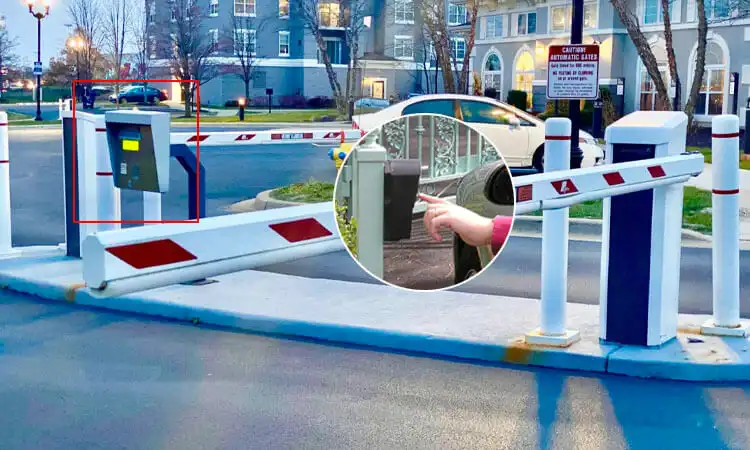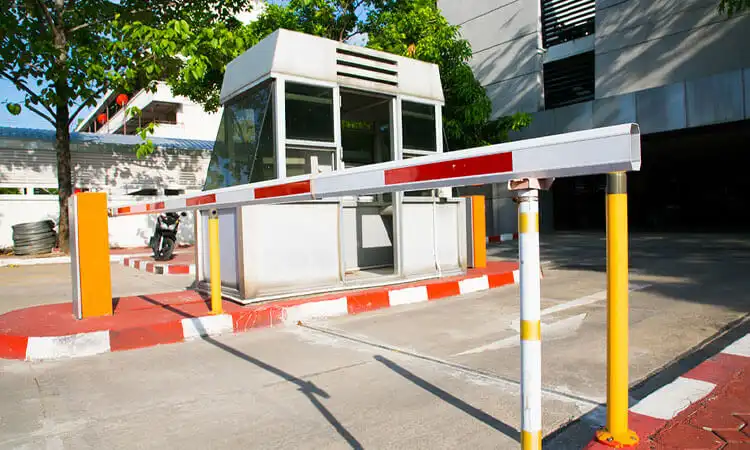As we move towards an increasingly connected digital world, the need for effective vehicle access control is becoming more pressing. With the rise of car thefts and unauthorized access, it’s crucial to have a reliable and secure access control system in place. Fortunately, various options are available, each with its advantages and disadvantages. In this article, we’ll explore the different types of vehicle access control systems and their benefits with the information. I believe this information will help you make an informed decision.
What is Vehicle Access Control
Vehicle access control is a security measure designed to restrict the entry and exit of vehicles in specific areas. The main objective of vehicle access control is to ensure that only authorized vehicles gain access to a particular location. Access control systems can be implemented in various locations. Such as residential areas, commercial establishments, and industrial facilities.
Access control systems range from simple manual methods such as security guards, vehicle access control gates, and vehicle access control barriers. Then to complex technological solutions such as RFID-based, key fob, and card access systems.
Implementing an efficient vehicle access control system helps prevent security breaches and reduces the risk of theft, vandalism, or other potential threats. It helps ensure the safety and security of individuals, property, and facilities.
Read more: Everything You Should Know About RFID Tags for Car
Benefits of Vehicle Access Control System (VACS)
There are several benefits of implementing VACS in specific locations.
- It improved security and safety. Access control systems ensure that only authorized vehicles can enter a specific area. It reduces the risk of theft, vandalism, or other potential threats.
- It also allows for better management and organization of the area. For instance, monitoring and controlling the number of vehicles entering a parking lot or a gated community is easier.
- Access control systems also provide better management and organization. It allows businesses or residential areas to track who enters or exits a location. This can help identify potential issues or problems that need to be addressed.
- Vehicle access control systems can increase efficiency and convenience by reducing the time and effort required to manage vehicle access. It eliminates the need for manual checks or guards at entry points. It saves time and resources.
- Vehicle access control systems can also provide data and reports on the number of vehicles entering and exiting the area, enabling better decision-making and planning.
How is Vehicle Access Control Achieved?

Vehicle access control can be achieved through various means. The most common method is through the use of access control systems. This can be classified into different types:
- RFID-based systems use radio frequency identification technology to communicate between a tag or card and a reader.
- Fob systems use a small device attached to a keyring to open gates or barriers.
- Parking attendants require personnel to monitor and control the entry and exit of vehicles.
- Smartphone apps allow drivers to enter and exit through a mobile application.
- Digital access control keypad systems require drivers to enter a code to gain access.
- Card access systems use a magnetic strip or proximity card to gain access.
- Biometric vehicle access systems use biometric identification. Such as fingerprints to verify drivers’ identities.
Each system has advantages and disadvantages, and the right one depends on the location’s specific requirements.
These systems can allow or deny access based on predetermined criteria. Such as time, date, and type of vehicle. They can be integrated with other security measures, such as surveillance cameras and alarms, to provide a more comprehensive security solution. Access control systems also provide data and reports for better decision-making and planning. This makes them an essential part of modern security systems.
Read more: Windshield Tag Buying Guide
8 Types of Vehicle Access Control Systems
Access control systems are designed to restrict the entry and exit of vehicles in specific locations. Various types of vehicle gate access control systems are available, each with unique advantages and disadvantages.
RFID-Based Vehicle Access Control System
RFID-based systems use radio-frequency identification technology to identify and authenticate authorized vehicles. The system consists of an RFID reader, an antenna, and an RFID tag installed in the vehicle. When the vehicle approaches the entry point, the RFID reader sends a signal to the RFID tag, which response with a unique code. The system then checks the code against a database to determine whether the vehicle is authorized to enter.
Benefits and Drawbacks of RFID Vehicle Access Vontrol System:
| Benefits | Drawbacks |
|---|---|
| Quick and easy identification of authorized vehicles | Expensive to implement and maintain |
| Contactless, reducing wear and tear on vehicles and access control systems | Range can be limited depending on the frequency used |
| Can be integrated with other security systems, such as surveillance cameras | Vulnerable to relay attacks if not properly secured |
| Can reduce the need for human intervention and manual identification processes | RFID tags can be lost or stolen, potentially allowing unauthorized access |
| Can improve traffic flow and reduce congestion at access points | RFID tags can malfunction or become damaged, potentially causing access issues |
UHF RFID Access Control System
UHF (Ultra High Frequency) RFID is a popular option for access control systems. It is like an RFID-based system. But operates at a higher frequency and can read tags from a greater distance. This makes it suitable for applications where vehicles, such as toll roads or parking lots, need to be identified at a distance.
Benefits and Drawbacks of UHF RFID Access Control System:
| Benefits | Drawbacks |
|---|---|
| Greater range and read speed compared to other RFID frequencies | Interference from other radio signals can affect performance |
| Can identify multiple vehicles simultaneously, reducing wait times | May require more power to operate, leading to higher energy costs |
| Can be integrated with other security systems, such as surveillance cameras | More expensive than other RFID frequencies |
| More secure than low-frequency RFID due to the difficulty of replicating UHF tags | UHF signals can be absorbed or reflected by certain materials, causing issues with detection |
| Can be used in a variety of weather conditions and environments | UHF tags can be more sensitive to orientation and require proper placement for optimal performance |
Fob Access Control System
Fob systems use a key fob that contains an electronic chip to identify authorized vehicles. The driver holds the key fob to the reader at the entry point. The system checks the codes on the keys against a database to determine if the vehicle is authorized for entry. The system is user-friendly and convenient and provides an additional layer of security.
Benefits and Drawbacks of Fob Access Control System:
| Benefits | Drawbacks |
|---|---|
| Easy to use and operate, requiring minimal training | Fobs can be lost or stolen, potentially allowing unauthorized access |
| Can be easily deactivated if a fob is lost or stolen | Fobs can be easily copied, potentially allowing unauthorized access |
| Fobs can be programmed with different levels of access permissions | Fobs can malfunction or become damaged, potentially causing access issues |
| Can be integrated with other security systems, such as surveillance cameras | Fobs can be expensive to replace, especially for large facilities or organizations |
| More affordable than some other access control options | Limited range compared to some other access control options, potentially causing delays at access points |
Parking Attendant
Parking attendants use human guards to monitor and control the entry and exit of vehicles in a specific area. This system suits locations with lower traffic volume and requires a more personalized approach.
Benefits and Drawbacks of Parking Attendant:
| Benefits | Drawbacks |
|---|---|
| Can visually confirm the identity of the driver | Requires additional staffing, potentially increasing labor costs |
| Can provide assistance to drivers, such as directions or help finding a parking spot | May be subject to human error, such as allowing unauthorized access or missing important details |
| Can help manage traffic flow and reduce congestion | Requires adequate staffing levels to ensure efficient operation |
| Can provide a personal touch to the parking experience | May not be suitable for high-volume parking areas or large facilities |
| Can serve as an additional layer of security by monitoring activity and reporting suspicious behavior | May not be practical or cost-effective for 24/7 operation |
Smartphone App
Smartphone apps allow drivers to use their smartphones to access the entry point. The driver downloads the app and registers their vehicle. And they receive a unique code that they can use to access the entry point. The system checks the code against a database to determine whether the vehicle can enter. The system is convenient and provides a high level of security.
Benefits and Drawbacks of Smartphone App:
| Benefits | Drawbacks |
|---|---|
| Convenient and easy to use, requiring no additional hardware | Requires a compatible smartphone and internet connectivity |
| Can be used remotely, allowing for pre-authorized access | Security concerns may arise due to the use of wireless communication and the potential for hacking or data breaches |
| Can be integrated with other smart building systems | May have limited functionality compared to other access control options |
| Can be programmed with different levels of access permissions | Can drain smartphone battery life, potentially causing inconvenience |
| Offers real-time access control monitoring and reporting | User error or technical glitches could potentially result in unauthorized access |
Digital Access Control Keypad System
The system requires users to enter a code on a keypad to gain access. The driver enters the code on a keypad. The digital access control keypad system checks the code against a database to determine whether the vehicle can enter. This system is affordable and easy to install, but it can be less secure than other systems since codes can be easily shared.
Benefits and Drawbacks of Digital Access Control Keypad System:
| Benefits | Drawbacks |
|---|---|
| Low cost and easy to install | Keypad codes can be shared or compromised, potentially leading to unauthorized access |
| Provides a simple and reliable method of access control | Requires manual entry of codes, potentially leading to user error or delays |
| Can be programmed with different levels of access permissions | Keypad buttons may become worn or damaged over time, leading to malfunction or failure |
| Can be used with different types of access codes, such as PIN numbers or swipe cards | Limited ability to monitor or track access control activity |
| Offers a higher level of security than traditional lock and key systems | Does not provide the same level of convenience as other access control options |
Card Access Systems and Proximity Access Cards
Card access systems use a card with an embedded microchip to communicate with the access control system. The system verifies the card or fob’s identity and allows access if it matches the authorized list.
Benefits and Drawbacks of Card Access Systems and Proximity Access Cards:
| Benefits | Drawbacks |
|---|---|
| Easy to use and can be programmed with different levels of access permissions | Can be lost, stolen or cloned, potentially leading to unauthorized access |
| Offers a high level of security, with encrypted data and authentication protocols | Requires additional hardware and infrastructure, such as card readers and access control software |
| Can be integrated with other security systems, such as video surveillance | Can be subject to wear and tear or damage, potentially leading to malfunction or failure |
| Provides a reliable and trackable method of access control | Can be vulnerable to hacking or data breaches, especially if the system is not properly secured |
| Can be used for both physical and logical access control | Card replacements and management can be time-consuming and costly |
Biometric Vehicle Access System Using Fingerprint Recognition
This system uses fingerprint recognition technology to grant access to authorized vehicles. The driver’s fingerprint is scanned, and the system verifies if it matches the authorized list before allowing access. This method provides a high level of security, but it can be costly to install and maintain.
Benefits and Drawbacks of Biometric Vehicle Access System Using Fingerprint Recognition:
| Benefits | Drawbacks |
|---|---|
| Provides a high level of security, with unique biometric identification | May not be suitable for all users, such as those with hand injuries or disabilities |
| Eliminates the risk of lost, stolen or cloned access devices | Requires additional hardware and infrastructure, such as fingerprint scanners and access control software |
| Provides a fast and convenient method of access control | Can be vulnerable to hacking or data breaches, especially if the system is not properly secured |
| Offers a reliable and accurate method of authentication | Can be affected by changes in fingerprint due to aging, injury, or environmental factors |
| Can be used for both physical and logical access control | May raise privacy concerns among users, especially if the system stores biometric data |
Vehicle access control is an essential aspect of modern security systems. Utilizing various access control systems can ensure the safety and security of their property and personnel. Implementing an effective vehicle access control system can increase efficiency, reduce risk, and improve overall security.
More Question About Vehicle Access Control
-
What are the basic controls in a vehicle?
The basic controls in a vehicle include the steering wheel, accelerator, brake pedal, gear selector, and dashboard controls. These controls enable the driver to maneuver and operate the vehicle safely and efficiently. The steering wheel changes the vehicle’s direction, while the accelerator and brake pedal controls the speed. The gear selector is used to change gears, and the dashboard controls include the speedometer, fuel gauge, and other indicators that provide information about the vehicle’s performance.
-
What are the barriers to prevent vehicle access?
There are various vehicle control barriers used to prevent unauthorized vehicle access. Including bollards, barricades, barriers, and gates. These barriers are typically made from steel or concrete and are designed to be strong enough to withstand vehicle impact. Bollards are short posts installed in the ground to create a physical barrier, while barricades and barriers are portable and can be moved as needed. Gates are typically used in conjunction with access control systems to prevent unauthorized entry. In addition to physical barriers, some locations may also use surveillance cameras, security personnel, or other monitoring systems to ensure the area’s security.
-
What is access control on a truck?
Access control on a truck refers to the system or mechanisms used to restrict access to certain areas or functions of the truck. This may include keyless entry, biometric verification, or electronic locks limiting access to the truck’s cab or cargo area.
-
What is access control for car parking?
Access control for car parking refers to the methods used to manage entry and exit to a parking area. This may include physical barriers such as gates or bollards and electronic systems that control access using keycards, access codes, or license plate recognition.
-
What is a VCU on a car?
A VCU on a car stands for “Vehicle Control Unit.” It is an electronic control unit that manages various systems within the car, such as the engine, transmission, and brakes. The VCU receives input from various sensors throughout the car and uses this information to decide how to control these systems to optimize performance, fuel efficiency, and safety.











